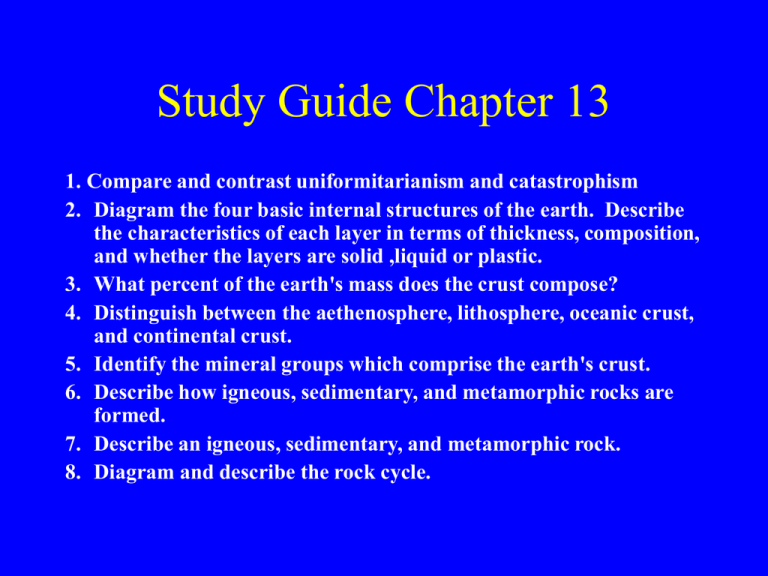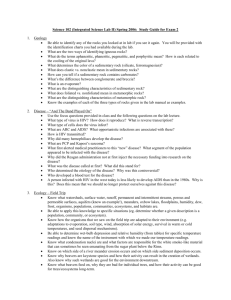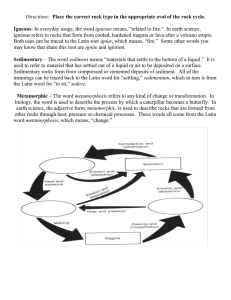4. Distinguish between the aethenosphere, lithosphere
advertisement

Study Guide Chapter 13 1. Compare and contrast uniformitarianism and catastrophism 2. Diagram the four basic internal structures of the earth. Describe the characteristics of each layer in terms of thickness, composition, and whether the layers are solid ,liquid or plastic. 3. What percent of the earth's mass does the crust compose? 4. Distinguish between the aethenosphere, lithosphere, oceanic crust, and continental crust. 5. Identify the mineral groups which comprise the earth's crust. 6. Describe how igneous, sedimentary, and metamorphic rocks are formed. 7. Describe an igneous, sedimentary, and metamorphic rock. 8. Diagram and describe the rock cycle. Study Guide Continued 9. Distinguish between rocks and minerals. 10.Describe and give examples of a divergent plate boundary. 11.Describe and give examples of lateral boundaries. 12.Describe and give examples of a convergent plate boundary. 13.Describe the theory of plate tectonics 14.What is sea floor spreading? 15.What is the name of the plate we are located on and what type of boundary is associated with California. Earth’s Materials, the Lithosphere and Plate Tectonics • • • • • Geomorphology Catastrophism Theory of uniformitarianism Tectonic forces versus gradational forces Estimated age of Earth is 4.5 billion years that’s 4500 million years. Geologic Eras • • • • PreCambrian-Most of geologic time Paleozoic Mesozoic Cenozoic- Our present era Earth’s Interior • • • • Inner core- Solid iron Outer core Mantle Crust- Only 1% of Earth’s total mass Fig. 13-18, p. 372 Fig. 13-20, p. 373 Fig. 13-25, p. 378 Plate Tectonics • Divergence (to pull apart) – Also know as sea floor spreading • Convergence (come together) – – – • Oceanic and continental (subduction) Continental and continental(mountains) Oceanic and oceanic (subduction) Lateral Movement (displaced) Fig. 13-28, p. 380 Sea Floor Spreading Fig. 13-26, p. 379 Fig. 13-34, p. 384 Fig. 13-22, p. 375 Simulation 18 Pangaea Evidence of Plate Tectonics • Dating of rocks – Oceanic rocks are much younger (200 million versus 4 billion years for continental – Younger to older parallel bands • Continental drift – Jigsaw shape of the continents Fig. 13-24a, p. 377 Evidence of Plate Tectonics • Plant and animal fossils – Australia and South America have similar tropical plant fossils and reptiles. • Mountain ranges – Similar across oceans Composition of Earth • The elements by percentages which make up the Earth are: – – – – Oxygen 47 Aluminum 8.1 Calcium 3.6 Potassium 2.7 Table 13.1 silicon 28 iron 5.0 sodium 2.8 magnesium 2.1 What is a mineral? • Elements come together to form minerals • General characteristics of minerals – – – – – 1.Natural ( not man made) 2.Inorganic 3.Crystalline 4.Solid 5.Constant chemical composition. What is a mineral? • Is air a mineral? • Is Oil? • Is Ice? Rock categories • Minerals come together to form rocks. • Three main categories of rocks – Igneous – Metamorphic – Sedimentary Igneous Rocks • Rocks that were molten rock and have solidified. • There are two types of igneous rocks – Plutonic rocks – Volcanic rocks Metamorphic Rocks • Rocks that have been under tremendous heat and pressure. • Change Sedimentary Rocks • Are derived from accumulated sediments. Deposited in layers and compacted by pressure from the materials above. Cemented. • Age of layers Sedimentary Rocks • Three categories of sedimentary rocks – Clastic: Are sedimentary rocks that broken and weathered fragments of preexisting rocks. – Organic: Dead plants and animals – Chemical: Rocks formed due to precipitation. Fig. 13-5, p. 364 Rock lab guidelines • Go by the numbers on the white pieces of paper in the tray. VERY IMPORTANT • Know the category-Igneous, metamorphic, sedimentary • Grades based on how many names correctly identified. • Each number unique name. No two the same. • No talking between groups. • One free check PER GROUP Fig. 13-3, p. 363 Rock lab • Omit – Igneous: gabbro, andesite – Metamorphic: schist, quartizite – Sedimentary: siltstone, shale,rocksalt,rock gypsum, tufa, organic limestone.







